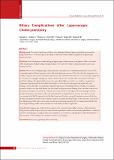Please use this identifier to cite or link to this item:
https://hdl.handle.net/20.500.14356/1965| Title: | Biliary Complications after Laparoscopic Cholecystectomy |
| Authors: | Koirala, U Subba, K Thakur, A Joshi, M R Thapa, P Singh, D R Sharma, S K |
| Citation: | KoiralaU., SubbaK., ThakurA., JoshiM. R., ThapaP., SinghD. R., & SharmaS. K. (2011). Biliary Complications after Laparoscopic Cholecystectomy. Journal of Nepal Health Research Council. https://doi.org/10.33314/jnhrc.v0i0.252 |
| Issue Date: | 2011 |
| Publisher: | Nepal Health Research Council |
| Article Type: | Original Article |
| Keywords: | Biliary tract Laproscopic cholecystectomy |
| Series/Report no.: | April;252 |
| Abstract: | Abstract Background: The reported prevalence of biliary tract disruption following laparoscopic cholecystectomy has ranged from 0% to 7% in early reports. Bile leaks are the most common biliary complication of laparoscopic cholecystectomy. Methods: Total 530 patients who had undergone laparoscopic cholecystectomy from January 2004 to November 2006 at Kathmandu Medical College Teaching Hospital were studied for biliary complications after laparoscopic cholecystectomy. Results: We reviewed 500 laparoscopic cholecystectomies performed at our institution and found 13 cases of bile extravasation and/or biloma formation and/or bile duct injuries (prevalence, 2.6%). One bile duct transection was acutely recognized and treated with hepaticojejunostomy. Three lateral bile duct injuries were also acutely recognized, two of them were managed with primary repair of CBD without T tube and the other was managed with repair and T-tube drainage. Two patients had postoperative generalized biliary peritonitis, one of whom was undergone exploratory laparotomy and found to have lateral injury on CBD which was managed with repair and T-tube drainage, whereas the other was undergone diagnostic laparoscopy with clipping of duct of Lushka. Two patients presented within seven days with biloma, one was treated with percutaneous drainage alone, the other treated with percutanous drainage was found to be complete transection of CBD on subsequent ERCP and managed with late hepaticojejunostomy. One patient with continued bile leak from surgical drainage tube for more than one week was managed with ERCP, diagnosed to be bile leak from duct of Lushka, managed by sphincterotomy and bile duct stenting. One patient presented with obstructive jaundice 6 months after laparoscopic cholecystectomy was found to have Bismuth type II bile duct stricture and was undergone hepaticojejunostomy. The remaining three had bile leak from surgical drainage which resolved within one week without further complication. Conclusions: Laparoscopic cholecystectomy appears to be associated with a higher incidence of bile duct injury than previous reports of open cholecystectomy. Possible explanations include variant anatomy plus failure to obtain an operative cholangiogram, inadequate dissection, injudicious use of cautery or clip placement, inherent limitations of the procedure, or the learning curve associated with a new technology. Key words: biliary tract, laproscopic cholecystectomy. |
| Description: | Original Article |
| URI: | http://103.69.126.140:8080/handle/20.500.14356/1965 |
| ISSN: | Print ISSN: 1727-5482; Online ISSN: 1999-6217 |
| Appears in Collections: | Vol 9 No 1 Issue 18 April 2011 |
Files in This Item:
| File | Description | Size | Format | |
|---|---|---|---|---|
| 252-Article Text-250-1-10-20130822.pdf | Fulltext Download | 189.87 kB | Adobe PDF |  View/Open |
Items in DSpace are protected by copyright, with all rights reserved, unless otherwise indicated.
